Detailed Analysis of the Stanford Prison Experiment in Psychology
VerifiedAdded on 2021/04/21
|6
|1483
|65
Essay
AI Summary
This essay provides an analysis of the Stanford Prison Experiment, a study conducted by Philip Zimbardo in 1971 to investigate the influence of social roles on behavior. The experiment involved college students assigned as prisoners and guards in a mock prison setting. The study aimed to understand whether individuals' behavior is determined by dispositional or situational factors. The essay examines the experiment's methodology, including the selection of participants and the simulation of prison conditions. It explores the observed behaviors of the participants, such as the guards' increasing cruelty and the prisoners' passivity. The analysis also addresses the experiment's premature termination due to the escalating severity of the situation. The essay delves into the debates surrounding the experiment, including discussions of its ethical concerns, validity, and generalizability. It references various criticisms and counterarguments, including those related to the study's ecological validity, population validity, and ethical guidelines. The conclusion highlights the experiment's impact on raising awareness of important issues, such as the treatment of juveniles in prisons and the importance of ethical research practices.
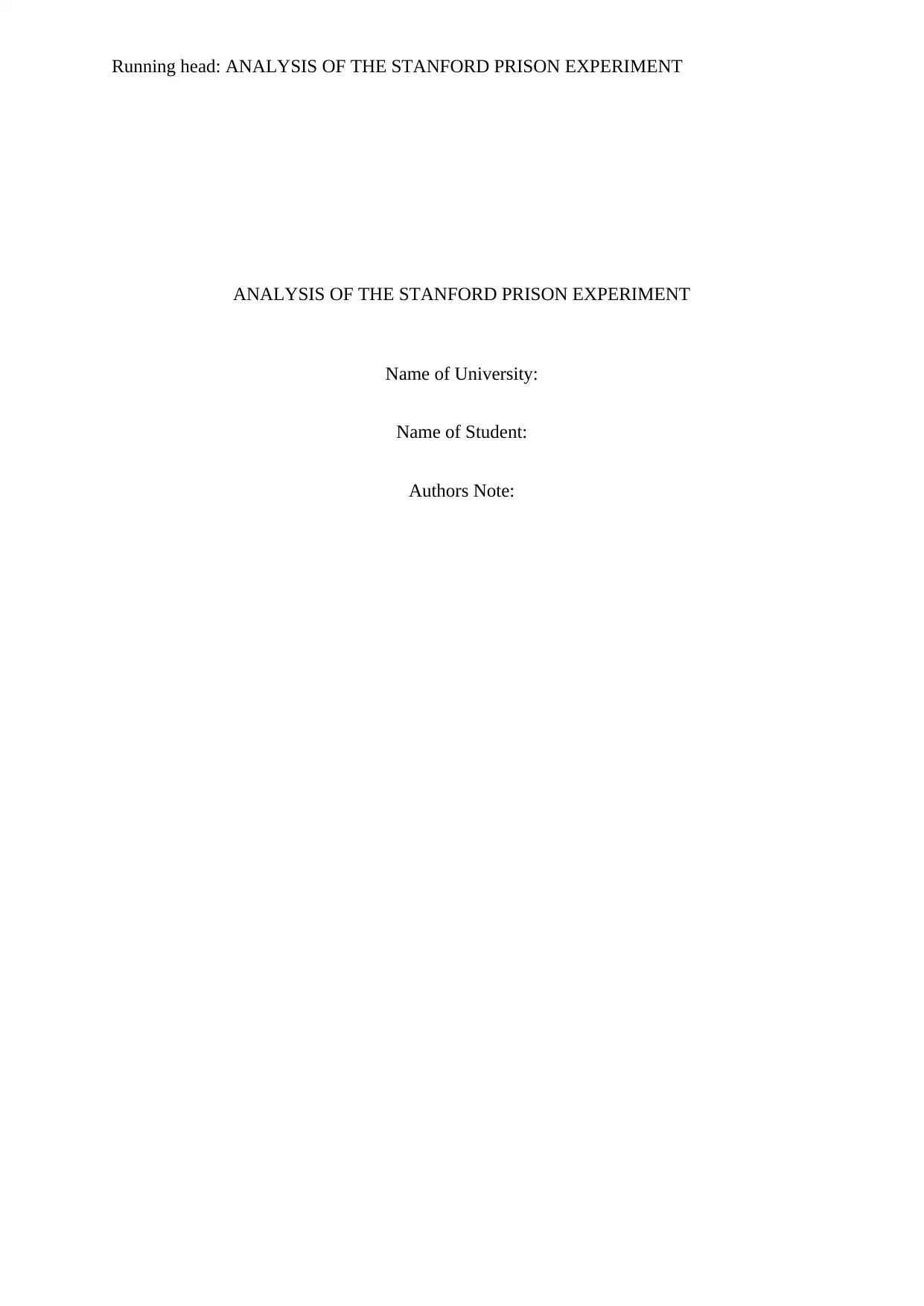
Running head: ANALYSIS OF THE STANFORD PRISON EXPERIMENT
ANALYSIS OF THE STANFORD PRISON EXPERIMENT
Name of University:
Name of Student:
Authors Note:
ANALYSIS OF THE STANFORD PRISON EXPERIMENT
Name of University:
Name of Student:
Authors Note:
Paraphrase This Document
Need a fresh take? Get an instant paraphrase of this document with our AI Paraphraser
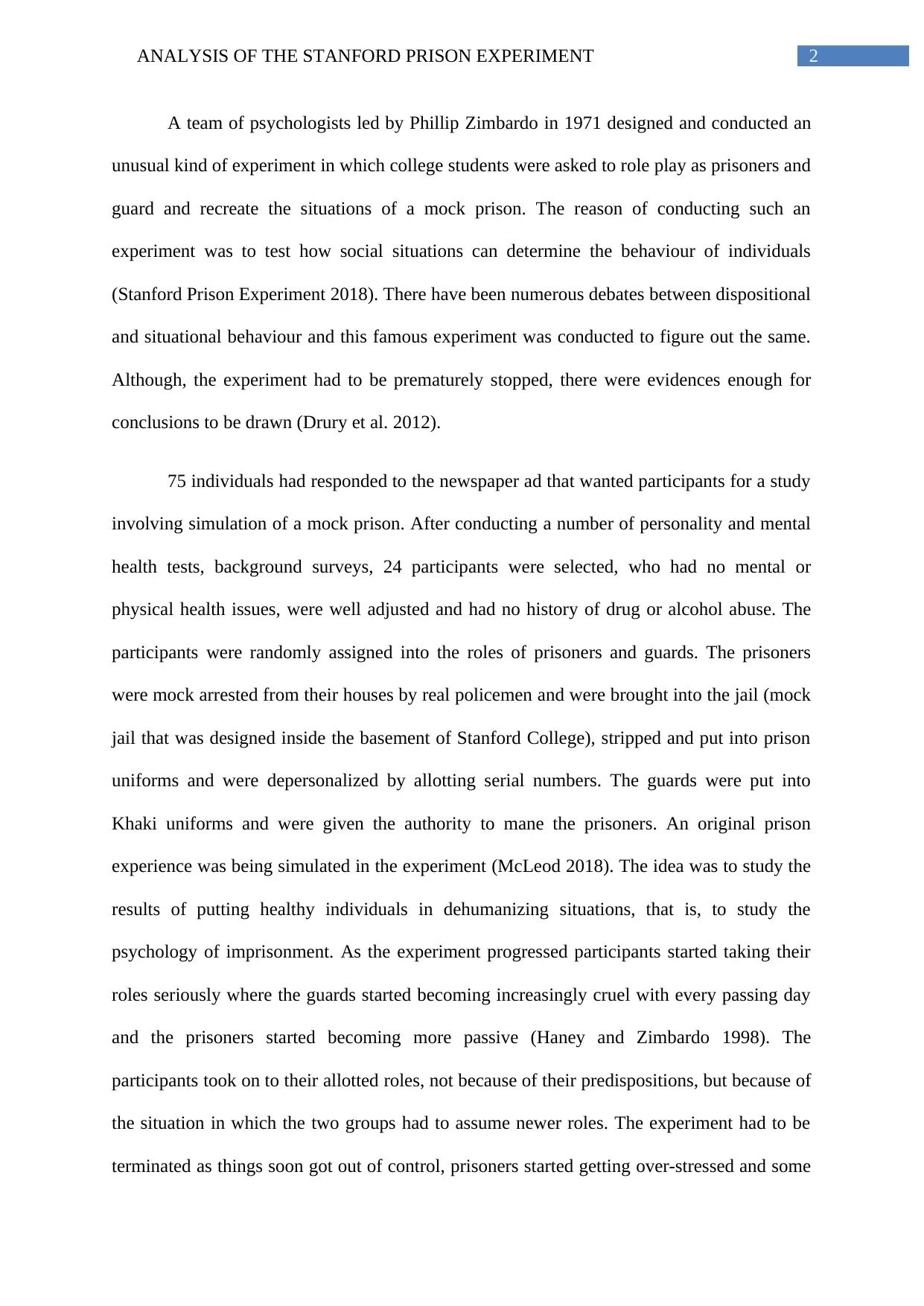
2ANALYSIS OF THE STANFORD PRISON EXPERIMENT
A team of psychologists led by Phillip Zimbardo in 1971 designed and conducted an
unusual kind of experiment in which college students were asked to role play as prisoners and
guard and recreate the situations of a mock prison. The reason of conducting such an
experiment was to test how social situations can determine the behaviour of individuals
(Stanford Prison Experiment 2018). There have been numerous debates between dispositional
and situational behaviour and this famous experiment was conducted to figure out the same.
Although, the experiment had to be prematurely stopped, there were evidences enough for
conclusions to be drawn (Drury et al. 2012).
75 individuals had responded to the newspaper ad that wanted participants for a study
involving simulation of a mock prison. After conducting a number of personality and mental
health tests, background surveys, 24 participants were selected, who had no mental or
physical health issues, were well adjusted and had no history of drug or alcohol abuse. The
participants were randomly assigned into the roles of prisoners and guards. The prisoners
were mock arrested from their houses by real policemen and were brought into the jail (mock
jail that was designed inside the basement of Stanford College), stripped and put into prison
uniforms and were depersonalized by allotting serial numbers. The guards were put into
Khaki uniforms and were given the authority to mane the prisoners. An original prison
experience was being simulated in the experiment (McLeod 2018). The idea was to study the
results of putting healthy individuals in dehumanizing situations, that is, to study the
psychology of imprisonment. As the experiment progressed participants started taking their
roles seriously where the guards started becoming increasingly cruel with every passing day
and the prisoners started becoming more passive (Haney and Zimbardo 1998). The
participants took on to their allotted roles, not because of their predispositions, but because of
the situation in which the two groups had to assume newer roles. The experiment had to be
terminated as things soon got out of control, prisoners started getting over-stressed and some
A team of psychologists led by Phillip Zimbardo in 1971 designed and conducted an
unusual kind of experiment in which college students were asked to role play as prisoners and
guard and recreate the situations of a mock prison. The reason of conducting such an
experiment was to test how social situations can determine the behaviour of individuals
(Stanford Prison Experiment 2018). There have been numerous debates between dispositional
and situational behaviour and this famous experiment was conducted to figure out the same.
Although, the experiment had to be prematurely stopped, there were evidences enough for
conclusions to be drawn (Drury et al. 2012).
75 individuals had responded to the newspaper ad that wanted participants for a study
involving simulation of a mock prison. After conducting a number of personality and mental
health tests, background surveys, 24 participants were selected, who had no mental or
physical health issues, were well adjusted and had no history of drug or alcohol abuse. The
participants were randomly assigned into the roles of prisoners and guards. The prisoners
were mock arrested from their houses by real policemen and were brought into the jail (mock
jail that was designed inside the basement of Stanford College), stripped and put into prison
uniforms and were depersonalized by allotting serial numbers. The guards were put into
Khaki uniforms and were given the authority to mane the prisoners. An original prison
experience was being simulated in the experiment (McLeod 2018). The idea was to study the
results of putting healthy individuals in dehumanizing situations, that is, to study the
psychology of imprisonment. As the experiment progressed participants started taking their
roles seriously where the guards started becoming increasingly cruel with every passing day
and the prisoners started becoming more passive (Haney and Zimbardo 1998). The
participants took on to their allotted roles, not because of their predispositions, but because of
the situation in which the two groups had to assume newer roles. The experiment had to be
terminated as things soon got out of control, prisoners started getting over-stressed and some
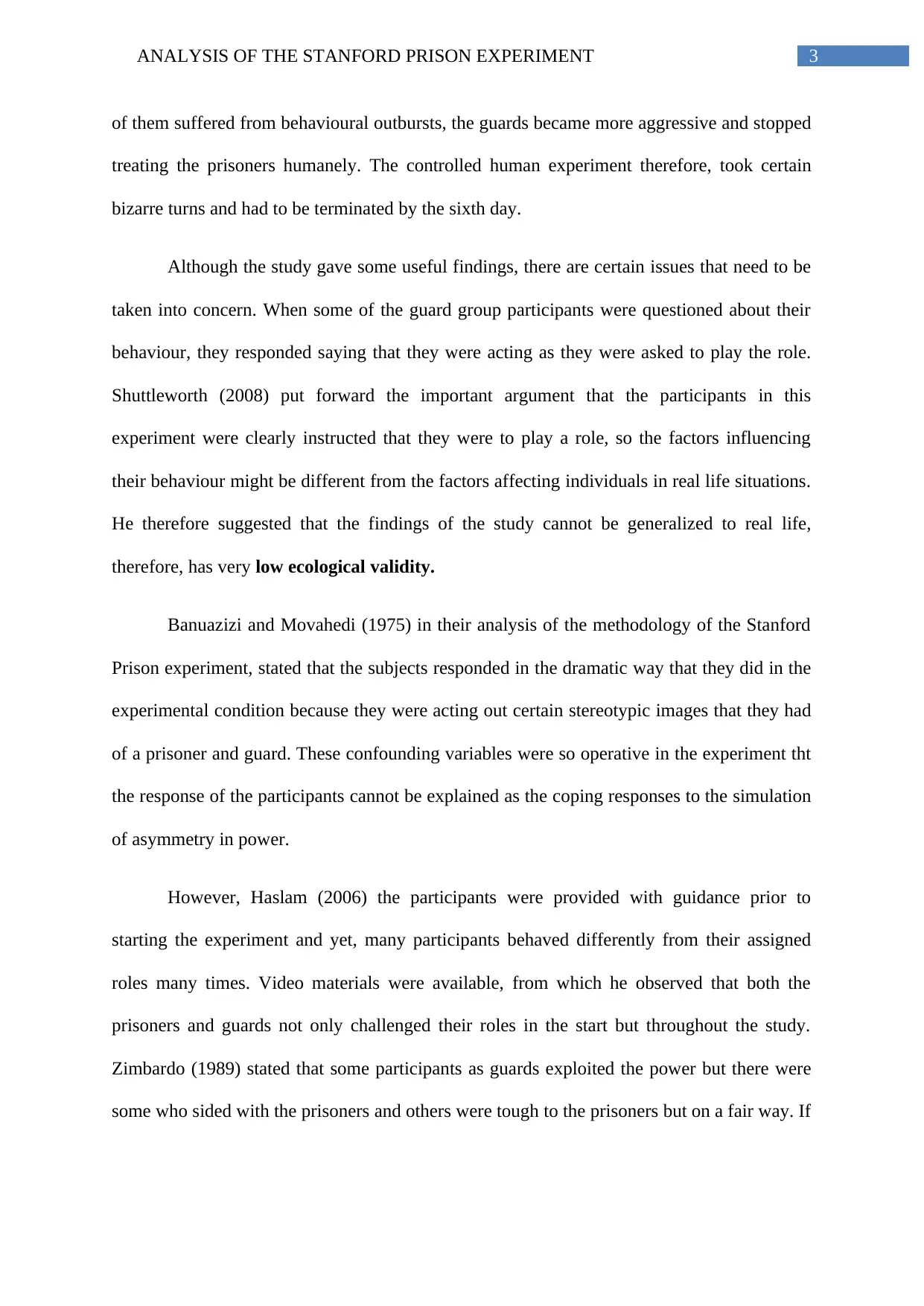
3ANALYSIS OF THE STANFORD PRISON EXPERIMENT
of them suffered from behavioural outbursts, the guards became more aggressive and stopped
treating the prisoners humanely. The controlled human experiment therefore, took certain
bizarre turns and had to be terminated by the sixth day.
Although the study gave some useful findings, there are certain issues that need to be
taken into concern. When some of the guard group participants were questioned about their
behaviour, they responded saying that they were acting as they were asked to play the role.
Shuttleworth (2008) put forward the important argument that the participants in this
experiment were clearly instructed that they were to play a role, so the factors influencing
their behaviour might be different from the factors affecting individuals in real life situations.
He therefore suggested that the findings of the study cannot be generalized to real life,
therefore, has very low ecological validity.
Banuazizi and Movahedi (1975) in their analysis of the methodology of the Stanford
Prison experiment, stated that the subjects responded in the dramatic way that they did in the
experimental condition because they were acting out certain stereotypic images that they had
of a prisoner and guard. These confounding variables were so operative in the experiment tht
the response of the participants cannot be explained as the coping responses to the simulation
of asymmetry in power.
However, Haslam (2006) the participants were provided with guidance prior to
starting the experiment and yet, many participants behaved differently from their assigned
roles many times. Video materials were available, from which he observed that both the
prisoners and guards not only challenged their roles in the start but throughout the study.
Zimbardo (1989) stated that some participants as guards exploited the power but there were
some who sided with the prisoners and others were tough to the prisoners but on a fair way. If
of them suffered from behavioural outbursts, the guards became more aggressive and stopped
treating the prisoners humanely. The controlled human experiment therefore, took certain
bizarre turns and had to be terminated by the sixth day.
Although the study gave some useful findings, there are certain issues that need to be
taken into concern. When some of the guard group participants were questioned about their
behaviour, they responded saying that they were acting as they were asked to play the role.
Shuttleworth (2008) put forward the important argument that the participants in this
experiment were clearly instructed that they were to play a role, so the factors influencing
their behaviour might be different from the factors affecting individuals in real life situations.
He therefore suggested that the findings of the study cannot be generalized to real life,
therefore, has very low ecological validity.
Banuazizi and Movahedi (1975) in their analysis of the methodology of the Stanford
Prison experiment, stated that the subjects responded in the dramatic way that they did in the
experimental condition because they were acting out certain stereotypic images that they had
of a prisoner and guard. These confounding variables were so operative in the experiment tht
the response of the participants cannot be explained as the coping responses to the simulation
of asymmetry in power.
However, Haslam (2006) the participants were provided with guidance prior to
starting the experiment and yet, many participants behaved differently from their assigned
roles many times. Video materials were available, from which he observed that both the
prisoners and guards not only challenged their roles in the start but throughout the study.
Zimbardo (1989) stated that some participants as guards exploited the power but there were
some who sided with the prisoners and others were tough to the prisoners but on a fair way. If
⊘ This is a preview!⊘
Do you want full access?
Subscribe today to unlock all pages.

Trusted by 1+ million students worldwide
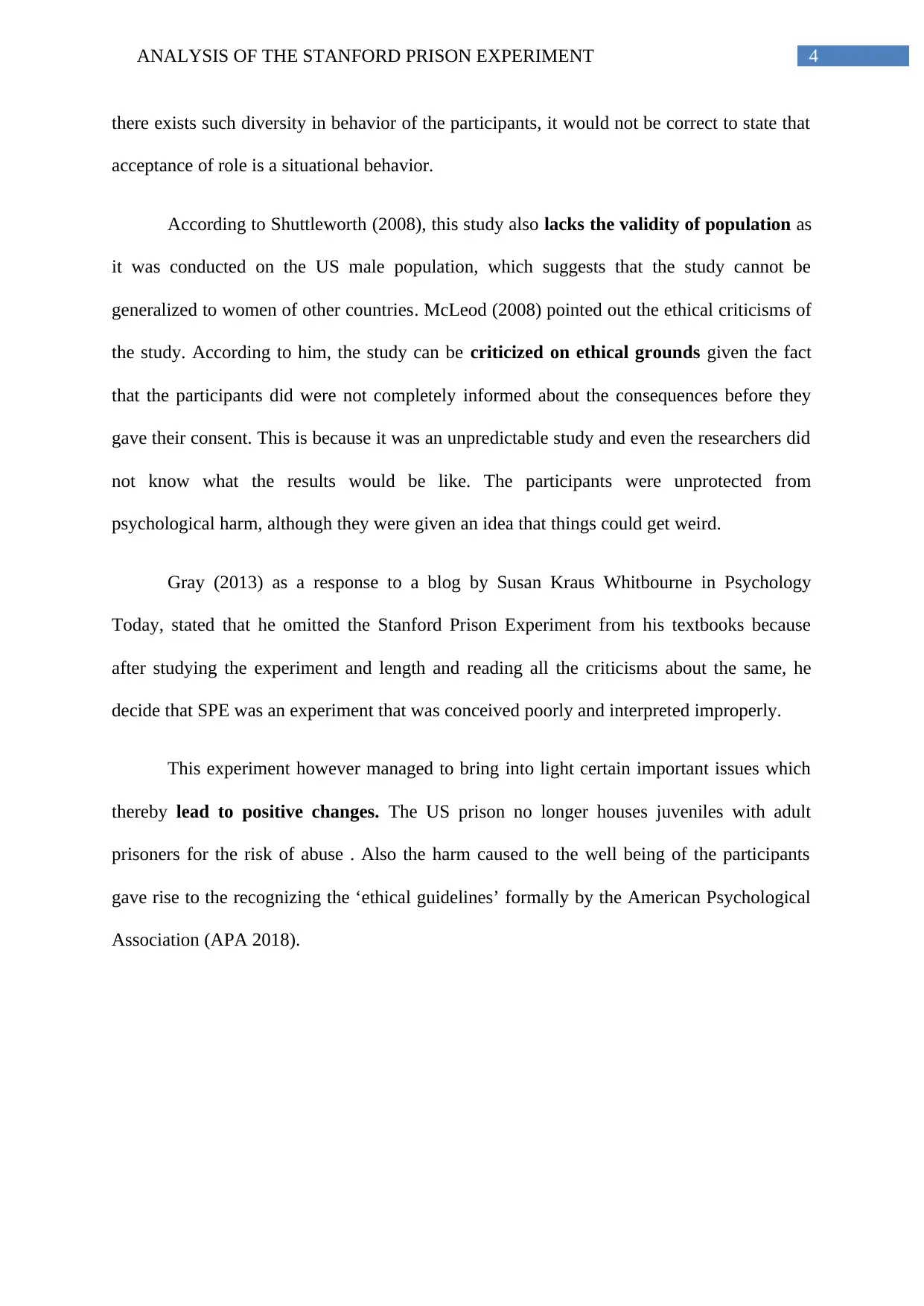
4ANALYSIS OF THE STANFORD PRISON EXPERIMENT
there exists such diversity in behavior of the participants, it would not be correct to state that
acceptance of role is a situational behavior.
According to Shuttleworth (2008), this study also lacks the validity of population as
it was conducted on the US male population, which suggests that the study cannot be
generalized to women of other countries. McLeod (2008) pointed out the ethical criticisms of
the study. According to him, the study can be criticized on ethical grounds given the fact
that the participants did were not completely informed about the consequences before they
gave their consent. This is because it was an unpredictable study and even the researchers did
not know what the results would be like. The participants were unprotected from
psychological harm, although they were given an idea that things could get weird.
Gray (2013) as a response to a blog by Susan Kraus Whitbourne in Psychology
Today, stated that he omitted the Stanford Prison Experiment from his textbooks because
after studying the experiment and length and reading all the criticisms about the same, he
decide that SPE was an experiment that was conceived poorly and interpreted improperly.
This experiment however managed to bring into light certain important issues which
thereby lead to positive changes. The US prison no longer houses juveniles with adult
prisoners for the risk of abuse . Also the harm caused to the well being of the participants
gave rise to the recognizing the ‘ethical guidelines’ formally by the American Psychological
Association (APA 2018).
there exists such diversity in behavior of the participants, it would not be correct to state that
acceptance of role is a situational behavior.
According to Shuttleworth (2008), this study also lacks the validity of population as
it was conducted on the US male population, which suggests that the study cannot be
generalized to women of other countries. McLeod (2008) pointed out the ethical criticisms of
the study. According to him, the study can be criticized on ethical grounds given the fact
that the participants did were not completely informed about the consequences before they
gave their consent. This is because it was an unpredictable study and even the researchers did
not know what the results would be like. The participants were unprotected from
psychological harm, although they were given an idea that things could get weird.
Gray (2013) as a response to a blog by Susan Kraus Whitbourne in Psychology
Today, stated that he omitted the Stanford Prison Experiment from his textbooks because
after studying the experiment and length and reading all the criticisms about the same, he
decide that SPE was an experiment that was conceived poorly and interpreted improperly.
This experiment however managed to bring into light certain important issues which
thereby lead to positive changes. The US prison no longer houses juveniles with adult
prisoners for the risk of abuse . Also the harm caused to the well being of the participants
gave rise to the recognizing the ‘ethical guidelines’ formally by the American Psychological
Association (APA 2018).
Paraphrase This Document
Need a fresh take? Get an instant paraphrase of this document with our AI Paraphraser
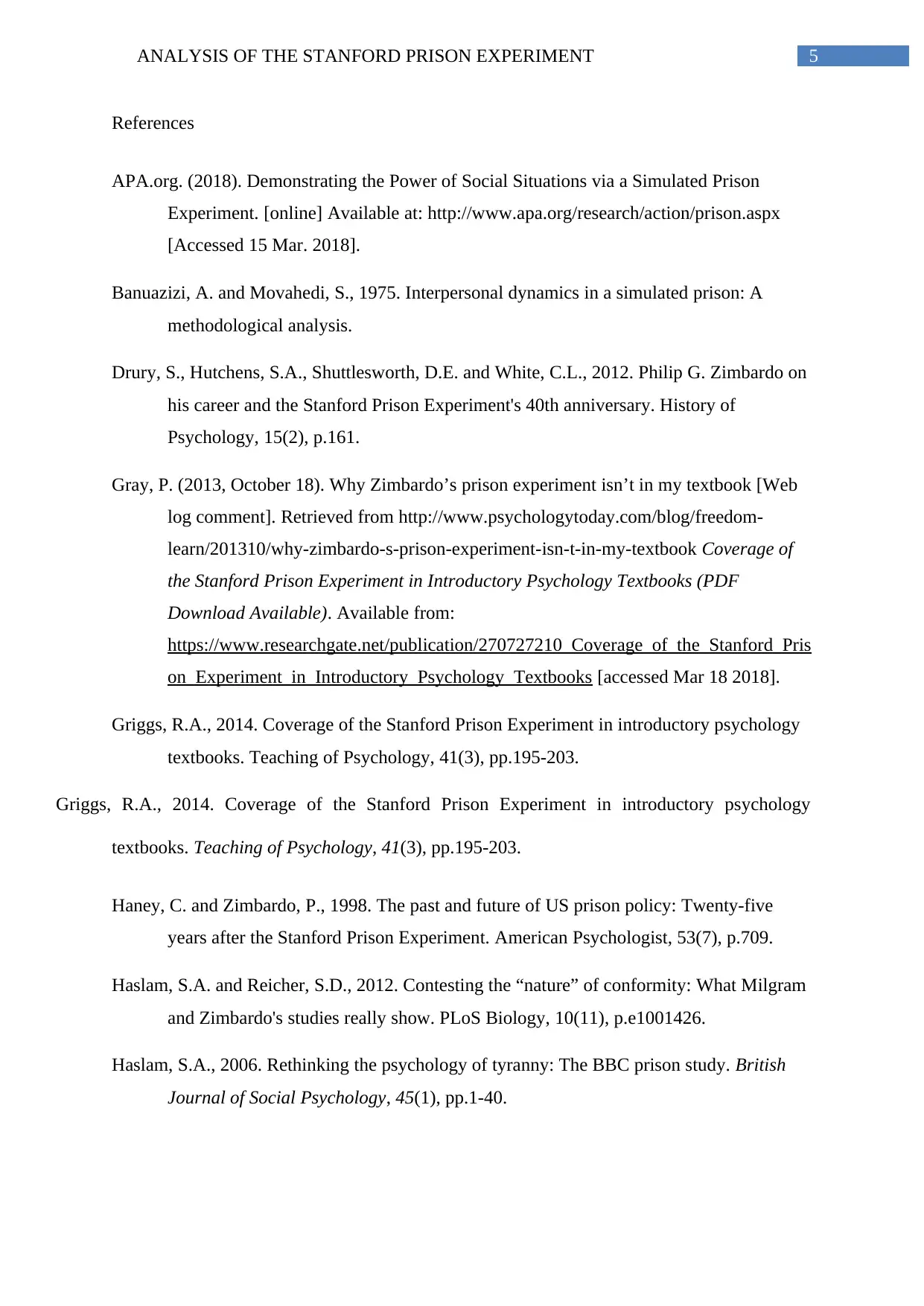
5ANALYSIS OF THE STANFORD PRISON EXPERIMENT
References
APA.org. (2018). Demonstrating the Power of Social Situations via a Simulated Prison
Experiment. [online] Available at: http://www.apa.org/research/action/prison.aspx
[Accessed 15 Mar. 2018].
Banuazizi, A. and Movahedi, S., 1975. Interpersonal dynamics in a simulated prison: A
methodological analysis.
Drury, S., Hutchens, S.A., Shuttlesworth, D.E. and White, C.L., 2012. Philip G. Zimbardo on
his career and the Stanford Prison Experiment's 40th anniversary. History of
Psychology, 15(2), p.161.
Gray, P. (2013, October 18). Why Zimbardo’s prison experiment isn’t in my textbook [Web
log comment]. Retrieved from http://www.psychologytoday.com/blog/freedom-
learn/201310/why-zimbardo-s-prison-experiment-isn-t-in-my-textbook Coverage of
the Stanford Prison Experiment in Introductory Psychology Textbooks (PDF
Download Available). Available from:
https://www.researchgate.net/publication/270727210_Coverage_of_the_Stanford_Pris
on_Experiment_in_Introductory_Psychology_Textbooks [accessed Mar 18 2018].
Griggs, R.A., 2014. Coverage of the Stanford Prison Experiment in introductory psychology
textbooks. Teaching of Psychology, 41(3), pp.195-203.
Griggs, R.A., 2014. Coverage of the Stanford Prison Experiment in introductory psychology
textbooks. Teaching of Psychology, 41(3), pp.195-203.
Haney, C. and Zimbardo, P., 1998. The past and future of US prison policy: Twenty-five
years after the Stanford Prison Experiment. American Psychologist, 53(7), p.709.
Haslam, S.A. and Reicher, S.D., 2012. Contesting the “nature” of conformity: What Milgram
and Zimbardo's studies really show. PLoS Biology, 10(11), p.e1001426.
Haslam, S.A., 2006. Rethinking the psychology of tyranny: The BBC prison study. British
Journal of Social Psychology, 45(1), pp.1-40.
References
APA.org. (2018). Demonstrating the Power of Social Situations via a Simulated Prison
Experiment. [online] Available at: http://www.apa.org/research/action/prison.aspx
[Accessed 15 Mar. 2018].
Banuazizi, A. and Movahedi, S., 1975. Interpersonal dynamics in a simulated prison: A
methodological analysis.
Drury, S., Hutchens, S.A., Shuttlesworth, D.E. and White, C.L., 2012. Philip G. Zimbardo on
his career and the Stanford Prison Experiment's 40th anniversary. History of
Psychology, 15(2), p.161.
Gray, P. (2013, October 18). Why Zimbardo’s prison experiment isn’t in my textbook [Web
log comment]. Retrieved from http://www.psychologytoday.com/blog/freedom-
learn/201310/why-zimbardo-s-prison-experiment-isn-t-in-my-textbook Coverage of
the Stanford Prison Experiment in Introductory Psychology Textbooks (PDF
Download Available). Available from:
https://www.researchgate.net/publication/270727210_Coverage_of_the_Stanford_Pris
on_Experiment_in_Introductory_Psychology_Textbooks [accessed Mar 18 2018].
Griggs, R.A., 2014. Coverage of the Stanford Prison Experiment in introductory psychology
textbooks. Teaching of Psychology, 41(3), pp.195-203.
Griggs, R.A., 2014. Coverage of the Stanford Prison Experiment in introductory psychology
textbooks. Teaching of Psychology, 41(3), pp.195-203.
Haney, C. and Zimbardo, P., 1998. The past and future of US prison policy: Twenty-five
years after the Stanford Prison Experiment. American Psychologist, 53(7), p.709.
Haslam, S.A. and Reicher, S.D., 2012. Contesting the “nature” of conformity: What Milgram
and Zimbardo's studies really show. PLoS Biology, 10(11), p.e1001426.
Haslam, S.A., 2006. Rethinking the psychology of tyranny: The BBC prison study. British
Journal of Social Psychology, 45(1), pp.1-40.
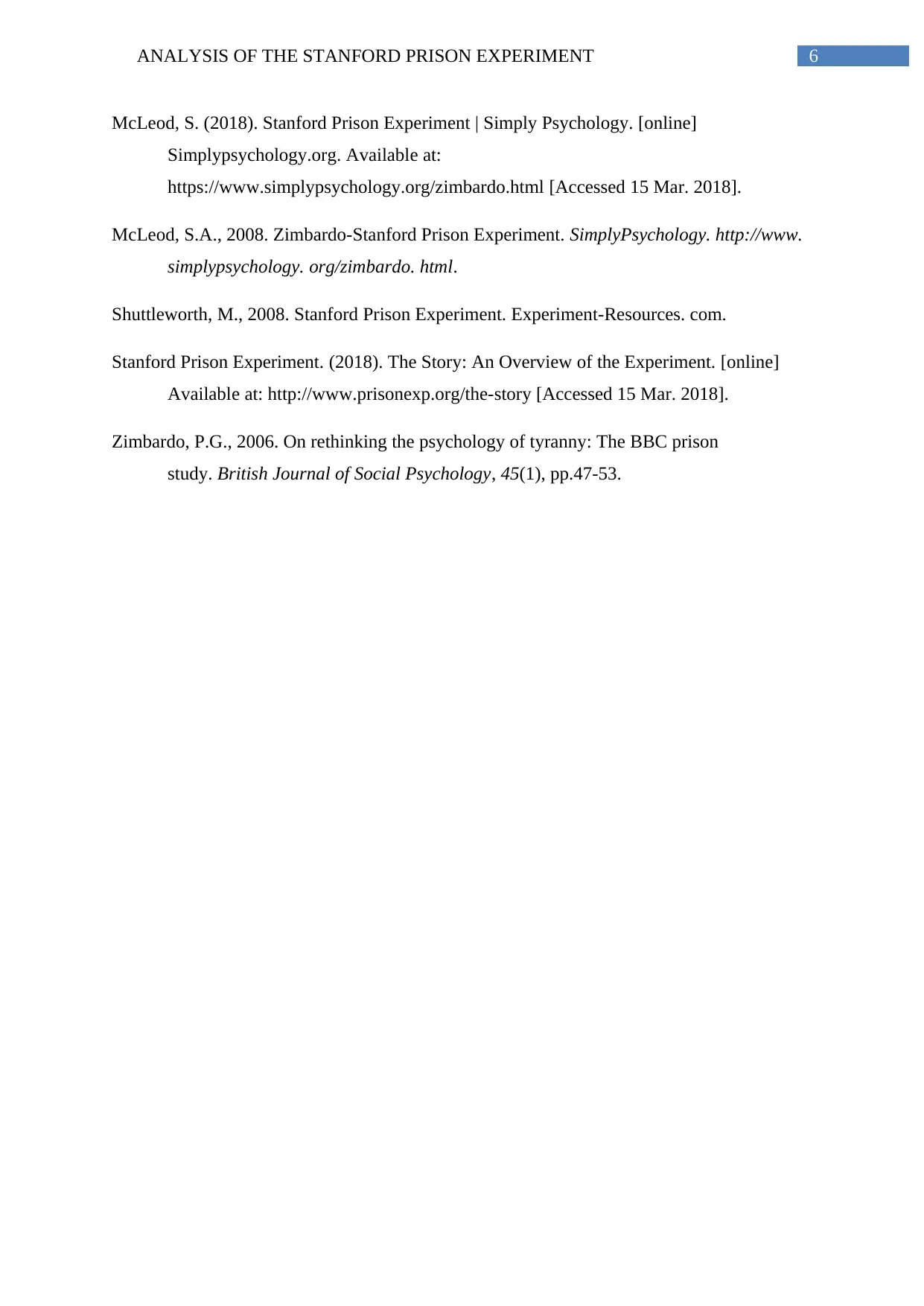
6ANALYSIS OF THE STANFORD PRISON EXPERIMENT
McLeod, S. (2018). Stanford Prison Experiment | Simply Psychology. [online]
Simplypsychology.org. Available at:
https://www.simplypsychology.org/zimbardo.html [Accessed 15 Mar. 2018].
McLeod, S.A., 2008. Zimbardo-Stanford Prison Experiment. SimplyPsychology. http://www.
simplypsychology. org/zimbardo. html.
Shuttleworth, M., 2008. Stanford Prison Experiment. Experiment-Resources. com.
Stanford Prison Experiment. (2018). The Story: An Overview of the Experiment. [online]
Available at: http://www.prisonexp.org/the-story [Accessed 15 Mar. 2018].
Zimbardo, P.G., 2006. On rethinking the psychology of tyranny: The BBC prison
study. British Journal of Social Psychology, 45(1), pp.47-53.
McLeod, S. (2018). Stanford Prison Experiment | Simply Psychology. [online]
Simplypsychology.org. Available at:
https://www.simplypsychology.org/zimbardo.html [Accessed 15 Mar. 2018].
McLeod, S.A., 2008. Zimbardo-Stanford Prison Experiment. SimplyPsychology. http://www.
simplypsychology. org/zimbardo. html.
Shuttleworth, M., 2008. Stanford Prison Experiment. Experiment-Resources. com.
Stanford Prison Experiment. (2018). The Story: An Overview of the Experiment. [online]
Available at: http://www.prisonexp.org/the-story [Accessed 15 Mar. 2018].
Zimbardo, P.G., 2006. On rethinking the psychology of tyranny: The BBC prison
study. British Journal of Social Psychology, 45(1), pp.47-53.
⊘ This is a preview!⊘
Do you want full access?
Subscribe today to unlock all pages.

Trusted by 1+ million students worldwide
1 out of 6
Related Documents
Your All-in-One AI-Powered Toolkit for Academic Success.
+13062052269
info@desklib.com
Available 24*7 on WhatsApp / Email
![[object Object]](/_next/static/media/star-bottom.7253800d.svg)
Unlock your academic potential
Copyright © 2020–2025 A2Z Services. All Rights Reserved. Developed and managed by ZUCOL.




